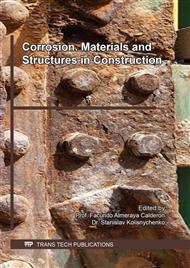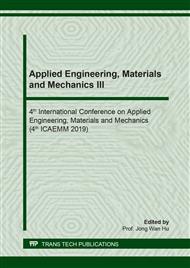p.92
p.99
p.104
p.113
p.118
p.123
p.128
p.134
p.139
Development of Sacrificial Anode Usable in High Specific Resistivity Solution by Parameter of Addition of NaCl
Abstract:
A sacrificial anode cathodic protection method has been widely used in the steel pile by galvanic current by potential difference between sacrificial anode and corrosive structural steel. And, the sacrificial anode cathodic protection method have generally merits compared to impressed current method because it can be applied to everywhere which is not connected with electricity. However, when the steel piles of the pier are submerged in low conductivity solution mixed with fresh water and sea water, the structural steel piles mentioned above have not been protected occasionally perfectively due to decreasing of galvanic current caused by deposited with oxide film on the surface of anode. In this study, five types of samples which are added with NaCl(g) to Zn anode were prepared with ratio of NaCl(g)/Zn(g)x100(%). And galvanic currents, surface morphologies characteristics of these samples was investigated using electrochemical methods such as polarization curves, galvanic current and analysis of surface morphologies before and after reduction weight ratio test in order to evaluate the effect of addition of NaCl(g) affecting to quality of zinc anode. The 2.6 % sample added with NaCl(5g) showed the highest value of galvanic current density in 0.8% NaCl solution, however, the highest reduction weight ratio was also observed at the 2.6% sample. Therefore, it is considered that the higher galvanic current density, the higher reduction weight ratio, that is, the life of sacrificial anode is shorted with increasing of galvanic current. Moreover, all samples added with NaCl(g) to Zn sacrificial anode indicated higher galvanic current density compared to the sample with no addition of NaCl(g) in low conductivity solution. Eventually, it is supposed that the galvanic current can be increased with addition of NaCl(g) to Zn sacrificial anode in low conductivity solution.
Info:
Periodical:
Pages:
139-144
Citation:
Online since:
August 2019
Authors:
Price:
Сopyright:
© 2019 Trans Tech Publications Ltd. All Rights Reserved
Share:
Citation:



